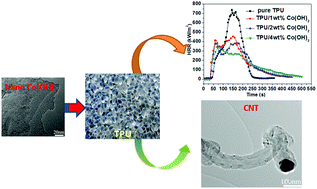Few layered Co(OH)2 ultrathin nanosheet-based polyurethane nanocomposites with reduced fire hazard: from eco-friendly flame retardance to sustainable recycling
Abstract
Huge consumption of thermoplastic polyurethane (TPU) results in two serious challenges for our society: fire hazards and environment pollution. To address these challenges, on the one hand, ultrathin β-Co(OH)2 nanosheets were devised and synthesized by a surfactant self-assembly technique and their application in TPU reduced the fire hazard; on the other hand, a green method was developed to sustainably recycle TPU nanocomposites into high value-added carbon materials. The structural characterizations demonstrate that the ultrathin β-Co(OH)2 nanosheets showed a typical two-dimensional lamellar morphology, possessing a lateral dimension of ca. 2 μm and a low thickness of ca. 2.6 nm, corresponding to the two layers of β-Co(OH)2. The incorporation of ultrathin β-Co(OH)2 nanosheets into the TPU matrix effectively reduced the heat release and restrained the toxicity of the volatiles, which was attributed to the ultrathin β-Co(OH)2 nanosheets in the TPU matrix offering an enhanced barrier effect and catalytic charring capability and Co3O4 decomposed from β-Co(OH)2 possessing superior catalytic oxidation of CO. Moreover, a green autocatalytic process in a sealed autoclave was developed to convert TPU/Co(OH)2 nanocomposites into high value-added Co/CNTs nanocomposites with more than 85% yield. This innovative idea may be expanded to other polymer systems and opens a new door to developing high performance polymer nanocomposites via green approaches and in particular, the sustainable recycling of the polymer-based materials.


 Please wait while we load your content...
Please wait while we load your content...